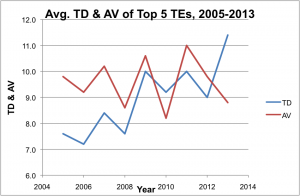[adsenseyu1]
I wanted to take a look today at Dez Bryant of the Dallas Cowboys, who is entering the final year of his contract and more or less proclaimed that he is a top five receiver in the NFL. I find Bryant a pretty intriguing contract negotiation since there are arguments that could be made on both sides for his salary and there are many potential risks and rewards associated with an early extension for Bryant.
The Salary Landscape
Here is the list of current top of the market players whose contracts were signed under the age of 30 (Bryant is 26 this season)

Bryant should have two goals in this negotiation. The first is to establish that he is far superior to the bottom four names on this list such that he, at the very least, begins a new salary tier for the position. The second is to argue that he should be paid alongside Johnson and Fitzgerald.
The Second Pay Tier
First I just want to look at base stats to quickly establish Bryant’s position among this group. Here is how Bryant’s three year performance stacks up against the average performance of the four players who make under $13 million a season.
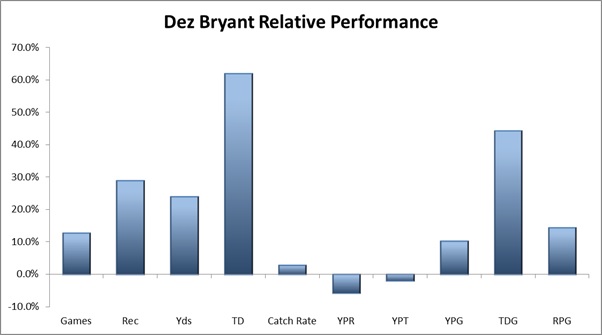
n terms of total usage, Bryant laps the field. He ranks first in games, receptions, yards, and touchdowns. However he ranks below average when we start looking at his performance per play where his yards per reception and yards per target both lag the field. Does that really matter though when working on a contract for a player with the physical abilities as Bryant? Probably not.
The Top Tier
The reason I stated above that the per play type data likely has limited effect on a contract is when you look at the three year numbers of Johnson and Fitzgerald, at the times they signed their contracts, to the average of the four second tier players and add them to the chart you get the following:
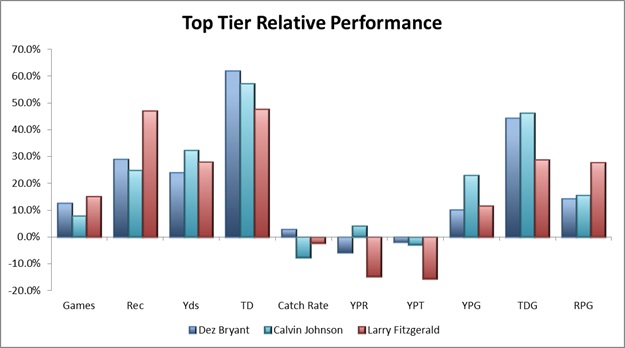
Those other players were unable to attain the salary levels of the big two despite the barely average or below average performances in those yards per reception and per target type categories. But Johnson and Fitzgerald were, much like Bryant, considered physical marvels at the position and not interchangeable pieces. The overall usage numbers indicate dominant and durable players at the position and they were thus paid accordingly.
Looking at it this way I think we can definitely make the argument that Bryant, among the group of current veteran contracts, is worthy of being no worse than the third paid player at the position. Getting him above $16 million a season, however, may not be easy.
His greatest asset is the ability to find the end zone. He has more touchdowns over this three year period than the other two did. He also is catching more passes that come his way, though he has played with the better QB over a three year stretch as well. On a per game basis he only slightly trails Johnson at 0.733 to 0.723 touchdowns per game. He is neck and neck with Johnson in receptions as well. His receptions are well behind Fitzgerald’s.
The major negative on Bryant being considered on par with these two players is his usage stats. The next time you see a Bryant outburst on the sideline about getting him the ball (however one wants to spin it) think about the fact that he gets one less target a game than Johnson and 1.5 less than Fitzgerald. That one added target would basically have put him on par with Johnson for yards and Fitzgerald for receptions. At that point you can make the case that he could warrant the largest contract at the position.
The fact that Dallas’ offense has so many passing options through the years has hurt Bryant. Loosely adjusted for games played, Bryant is responsible for about 22.5% of his teams’ targets. Johnson was at 24.4% and Fitzgerald 26.9%. Among the first and second tier, his team usage ranks just 5th, just ahead of Wallace and Jackson (Harvin and Bowe both benefitted from being on poor teams with limited alternatives).
It’s the one area of statistical dominance that he can not claim right now and it is doubtful that will change. There are a few arguments that he can bring to the discussion regarding that. One is that he is the only one of the two players to play with a dominant tight end in Jason Witten. Jackson had a similar situation with Antonio Gates in San Diego. When it comes to actual attention among wide receivers on the Cowboys, Bryant’s numbers are more impressive.
Secondly I think it would be worth bringing up the fact that Witten is 32 years old and may not have as many seasons left as a dominant player. Once that happens the fact is Bryant can pick up the slack and get those dominant numbers that compare with Johnson and Fitzgerald.
Finally, Bryant is just 26 years old and has years of exceptional football ahead of him. Unlike many other players you are not going to pay for non-results on the backend of a contract, but will get a dominant player for at least four years if not more.
Where Should His Salary Fit
Based on the fact that this is the Dallas Cowboys, who have gone above and beyond for certain players, I think Bryant should have a compelling case to come in very close to those top two players. Can he reach $16 million? I don’t think that is a possibility. Both Johnson and Fitzgerald had their teams over a barrel in regards to salary cap charges and contract structures which helped get them the deals they received. Bryant is by no means an albatross on the Cowboys salary cap right now and Dallas is probably fluid enough with the cap to be able to threaten back to back franchise tags, which would leave him somewhere between $28 and $29 million in earnings over a two year period..
I think the challenge here should come with designing the 1A tier that is lacking. How much above the second tier average of $11.79 million makes Bryant happy while also being acceptable to the Cowboys? I would think the range here would be $14.7 to $15.3 million a season. I think there is also a point to be made here that Johnson’ five year contract value works out to $15.6 million a season, so coming in close to $15 million is really not that far off from true top of the market pricing.
In terms of years I think the deal has to be similar to the big two at 7 years. That is necessary for salary cap flexibility and can also give Bryant the important distinction of having a $100 million contract. If the $100 million number is a big deal they may be able to push the annual value down to the $14.3 million level, but I’m just guessing as to that being a big benchmark for Bryant. It might not be and they may be more interested in hitting $15 million a year as a benchmark.
Cash flows of the contract will be an important issue. Johnson received $45.75 million over the first three years of his contract. Harvin will receive $43.145 million. Harvin also could have been threatened with multiple franchise tags and that had no bearing on his extension numbers. I think Bryant needs to come in between both players and I don’t feel that it would be acceptable to him to receive the $37 million total that went Wallace unless that number was fully guaranteed from day one. Both Harvin and Johnson present better comparisons as well because they both had one year remaining under contract when extensions were signed.
Here is the breakdown of how the Harvin and Johnson yearly annual values work out over the first five years of their contract:
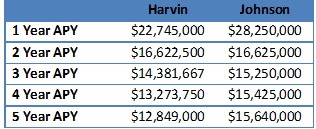
There are a couple of interesting things to note here. One is the structure of the deals. Harvin’s is a pure waterfall style contract that starts high and continues to come down. Johnsons follows a unique pattern in that the APY falls and then rises again in a u-shape. That is very uncommon, but marked the importance for Johnson to eventually get to a final annual value of over $16 million while the Lions were likely stuck working in the $15.5 million range. This is the compromise and the type of structure I would suggest for Bryant as well, except $15 million being his maximum value. The other interesting point is how close the two year values on the contract are. Basically Harvin and Johnson should set the parameters for the first three years of payments pretty easily.
The other thing that stands out is just how strong the Harvin contract was in terms of cash flows. Harvin’s three year annual value was nearly a 1.12 multiple of the five year value. Most other players are in the ballpark of 1. The tradeoff for Harvin was the low guarantee compared to the others at the position. Harvin received just $14.5 million in full guarantees with a maximum guarantee of $25.5 million. Wallace received $27 million fully guaranteed upon signing and $30 million in total guarantees. Johnson received nearly $49 million in fully guaranteed salary. Each of these numbers is important, but the Harvin model should be paid attention to if Bryant’s camp would not agree to a “reasonable” contract and Dallas felt compelled to keep him at a higher number.
Based on the structures of the contracts I would suggest a cash flow to be somewhat along these lines for Bryant, assuming our seven year value ends up around $15 million, which again I think is the maximum he will get.
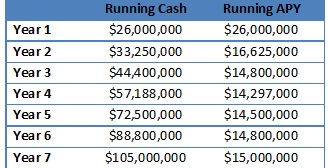
How might we structure such a deal? Right now Dallas has around $10 million in cap space in 2014 following the $5.5 million in cap savings that they earned from Miles Austin coming off the books. They still have to sign their first two draft picks which will result in a net loss of cap room of about $1.6 million. Assuming that they have no other major signings to make this year they should be able to afford to increase Bryant’s cap charge by $4 million and still get by for the season.
In 2015 Dallas has $138 million currently on the cap, but that includes charges for Doug Free and Kyle Orton, both of whom will have their contracts void, creating another $9 million in cap space. Henry Melton has a $9.25 million cap charge which would never occur. He would either be released or restructured for added cap space. In 2016 the team can begin to turn over the roster without devastating salary cap issues. My goal is to keep the cap charges moderate enough to where I don’t feel forced to restructure the contract in 2015 or 2016.
I think a very fair offer is a $20 million signing bonus with no other change to Bryant’s 2014 salary. That would bump his compensation this year to $22.03 million which actually exceeds Johnson’s salary in his extension year. Dallas can go lower than that and have it still be acceptable but for salary cap purposes I’d rather give the big bonus and work on a payment schedule that the team will find adequate for cash purposes. The initial guarantee would consist of the signing bonus, 2014 and 2015 base salaries and half of the 2016 salary. I’d give an injury guarantee on the other half of the 2016 salary and $10 million of his 2017 salary with the opportunity to earn a full guarantee if on the roster in March of those respective years. That works out to a full guarantee of $31.405 million and injury guarantee of $45.03 million.

I like this structure because it gives me Bryant at reasonable cap figures for the next three years that should not be difficult to handle under the current roster makeup. If I absolutely have to I can take money in 2015 or 2016 and prorate it, but I should not have to here. Bryant will turn 30 in 2018 and I would have a good deal of leverage to bring his numbers down if he was no longer an elite receiver at that stage. If he was still a terrific receiver I have plenty of years to prorate money into and work out more reasonable numbers.
Those numbers seem large, but I would not be that worried in the event he was dominant. In this structure his plus 30 years (2018 to 2021) would amount to $60.6 million in non-guaranteed compensation. Brandon Marshall, who would be the elite standard bearer for the plus 30 extension, will earn $39.3 million over a 4 year period. Assuming $7 million a year in cap growth, Marshall’s contract uses up around 6.8% of the total cap room. If the cap grows at the same figure then it’s about 8.8% for Bryant. That’s certainly higher but it is not crippling.
Potential Risk of Not Signing
Outside of injury risk, which exists for every player in the NFL, there are two unique circumstances that might pertain to Bryant which could impact a contract offer made in 2015. The first deals with his quarterback, Tony Romo. Romo has now undergone two back surgeries in the last two years and I think there are some legitimate questions about his health this season. With Orton claiming he will retire from the NFL that would leave Bryant catching passes from the likes of Brandon Weeden. That can crush his statistical production and bring questions up as to how QB dependent Bryant may be.
The other risk lies with the position where three big time receivers will also be up for possible extensions during this year. Those players are AJ Green, Julio Jones, and Demaryius Thomas. Here is how this group matches up in some of the major receiving categories.
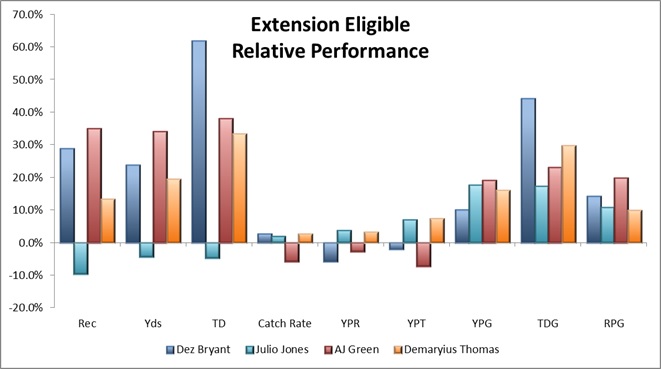
There should be no argument that Green is the superior receiver. The case is going to be made that he is superior to Johnson and Fitzgerald at the times they signed their deals and it is a solid case. The only place where he lacks is touchdowns. The other two players you can make a case for as being somewhat equal to Bryant, depending on how much you believe that the players will remain healthy. Thomas is probably most similar in terms of offensive importance and potential QB dependence.
Now there is nothing wrong with dropping from 3rd to 4th or 5th best, but the danger comes in the contract possibilities. Right now the market is set in stone with overpaid players like Wallace and Harvin and the big two on top. Dallas has always been very fair with their players within the existing frameworks of contracts at a position. The same can not be said of the Denver Broncos and Cincinnati Bengals who seem to be much more difficult to deal with on big contracts.
If Bryant plays things out and those two players decide to sign extensions with their respective teams (Jones would be less of a risk to sign a monster deal off injury) it could change the landscape of the WR market and solidify the Johnson and Fitzgerald deals as unattainable outliers. If, for example, Green signs for $13.3 million a season, Bryant has almost no leg to stand on when asking for the moon. At that point it’s about getting a little more than Harvin with strong up front guarantees. Any of these players coming in low in dollars more or less signals that both the club reps and the player agents agree the Wallace, Harvin, and Bowe deals are all invalid and carry the asterisk that nobody would have close to matching those contracts. It also further solidifies the top two being unattainable.
Of course it can work the other way as well. If Jones or Thomas signed in the $14 million plus range it makes getting $15 million an easier task. If Green somehow was to surpass the Johnson contract Bryant should be able to push even higher than $15 million as it redefines the WR market and validates the contracts at the top and second tiers. I find this scenario less likely, but it could be a consideration.
Bryant also has the ability to explode this year and take the leap into the next level when it comes to production. If he opts to play things out and does something like the 1,700 yard type season Johnson put up in 2011 when he earned the monster extension than Bryant can increase his asking price. That should also give him a year that surpasses anything Green does if Green gets an extension.
These are all considerations that both sides need to take into account if they open negotiations over the next few months.
The Final Verdict
I think both sides will benefit in the long run by trying to do a contract now rather than waiting. I think it benefits the Cowboys on the salary cap and locks up Bryant pretty much for his career. Bryant does deserve recognition as one of the top few players in the NFL at the position and should be paid accordingly. For all of the negatives we hear about Bryant I don’t think it has ever impacted his play nor does he give off the vibe that he is a take the money and run player, cruising through the next two or three seasons and collecting a paycheck. It will definitely be a fun situation to keep an eye on and one that maybe will start to play out over the summer.
[adsenseyu2]
[adsenseyu4]
[subscribe2]

